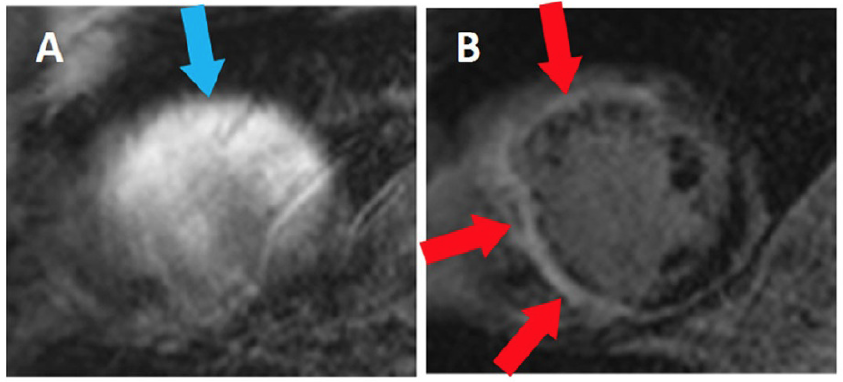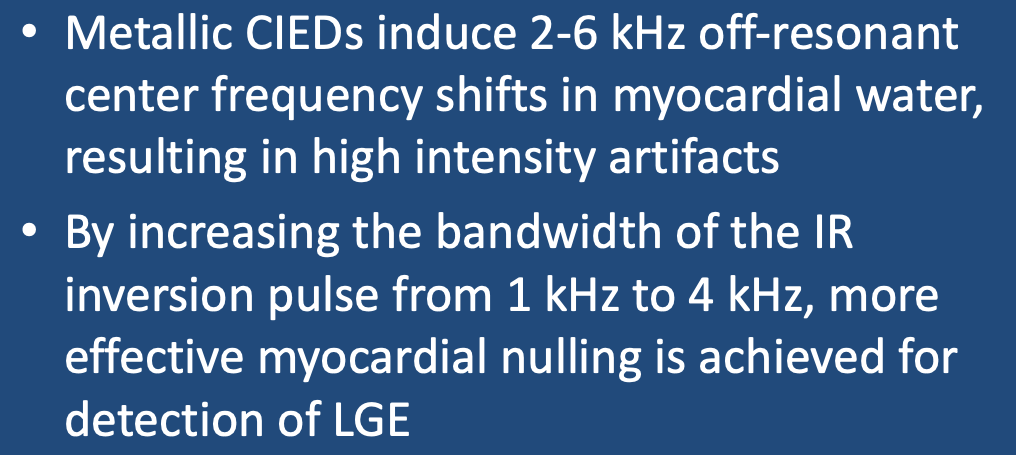Detection of late gadolinium enhancement (LGE) in the myocardium may be difficult when an indwelling ICD or pacemaker is present. Metal-containing CIEDs located 5-10 cm away from the heart can induce off-resonance shifts in the water center frequency of 2-6 kHz, rendering standard RF-inversion pulses ineffective. The signal from the myocardium is not properly inverted/nulled, resulting in hyperintense artifacts on LGE images that may obscure much of the heart.
To overcome this limitation, Rashid et al utilized a wideband (3.8 kHz) adiabatic hyperbolic secant IR pulse to replace the "standard" 1.1kHz pulse at 1.5T with great success, and these results have now been extended to both 3-dimensional acquisitions and higher field strengths. Wideband LGE options are now commercially available on MR systems offered by the major vendors.

Conventional (A) and Wideband (B) LGE images of patient with an ICD. Note severe hyperintensity artifact (blue arrow) in the conventional sequence, preventing the assessment of scar. Removal of this artifact in the wideband LGE image reveals scar tissue (red arrows) within the anterior and septal walls of the left ventricle. (From Rashid et al 2014 under CC-BY).
Limitations/disadvantages of the wideband technique include decreased number of slices compared to conventional LGE and failure to correct for susceptibility-induced spatial distortions.
Advanced Discussion (show/hide)»
No supplementary material yet. Check back soon!
References
Ranjan R, McGann CJ, Jeong E-K, et al. Wideband late gadolinium enhanced magnetic resonance imaging for imaging myocardial scar without image artefacts induced by implantable cardioverter-defibrillator: a feasibility study at 3 T. Europace 2015; 17:483-488. [DOI LINK]
Rashid S, Plotnik A, Litt H, et al. Artifact reduction with a wideband late gadolinium enhancement (LGE) MRI technique for patients with implanted cardiac devices: a two-center study. J Cardiovasc Magn Resonance 2014; 16(Suppl 1):O29. [DIRECT LINK]
Rashid S, Rapacchi S. Vaseghl M, et al. Improved late gadolinium enhancement MR imaging for patients with implanted cardiac devices. Radiology 2014; 270:269-274. [DOI LINK]
Ranjan R, McGann CJ, Jeong E-K, et al. Wideband late gadolinium enhanced magnetic resonance imaging for imaging myocardial scar without image artefacts induced by implantable cardioverter-defibrillator: a feasibility study at 3 T. Europace 2015; 17:483-488. [DOI LINK]
Rashid S, Plotnik A, Litt H, et al. Artifact reduction with a wideband late gadolinium enhancement (LGE) MRI technique for patients with implanted cardiac devices: a two-center study. J Cardiovasc Magn Resonance 2014; 16(Suppl 1):O29. [DIRECT LINK]
Rashid S, Rapacchi S. Vaseghl M, et al. Improved late gadolinium enhancement MR imaging for patients with implanted cardiac devices. Radiology 2014; 270:269-274. [DOI LINK]
Related Questions
How do you set the IR parameters to achieve desired image contrast?
How do you set the IR parameters to achieve desired image contrast?
